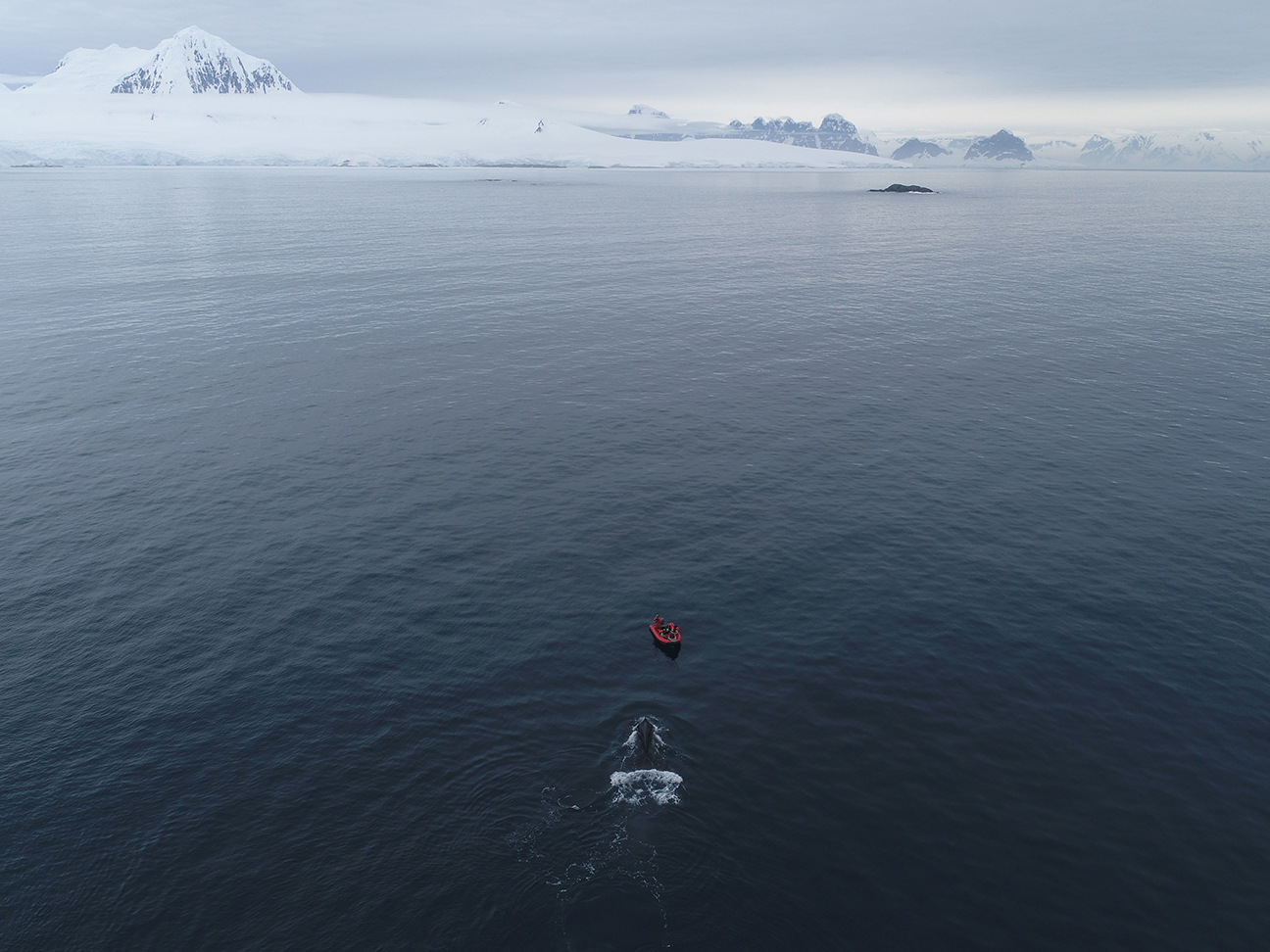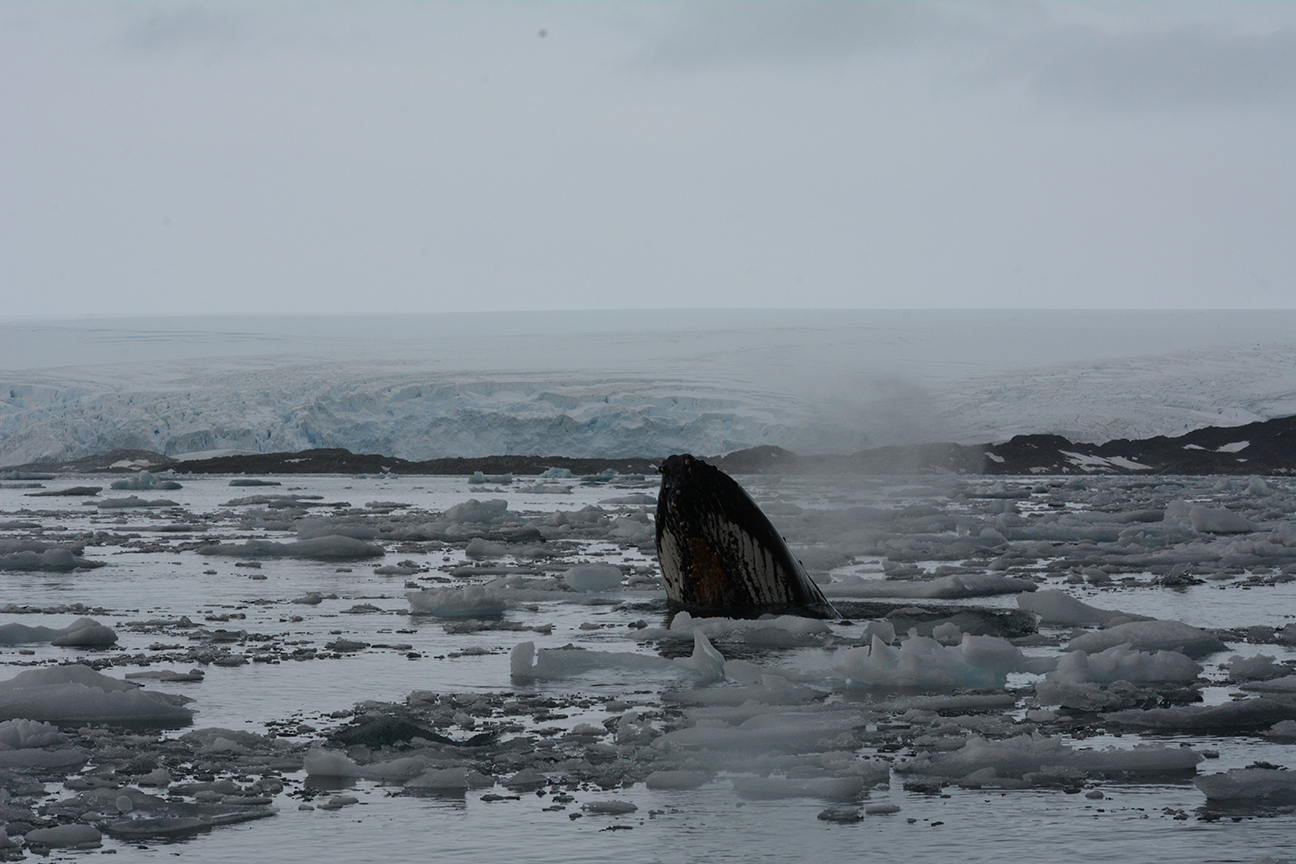A Humpback mother-calf pair foraging at the surface together off the coast of Anvers Island, Antarctica with a flock of Kelp Gulls following along. Photo was collected as part of an NSF funded research project by the Friedlaender Bio-Telemetry and Behavioral Ecology Lab under permits ACA 2020-016 and NMFS 23095 | Photo by Gregory Larsen.
| FEATURED
By Kyle Martin
On March 9, just before the United States began diving headfirst into full-blown crisis-pandemic-mode, Shirel Kahane-Rapport, a marine researcher with Stanford University doing a study in Antarctica, received an ominous text from a friend checking in on her.
The text said: “Are you aware that the world is on fire?”
“I actually have no idea what you’re talking about,” she responded. “Please advise.”
And then she and her crewmates began catching up.
In the same period of time businesses began to shutter and cases started to climb, a small cadre of Santa Cruz- and Bay Area-based scientists found themselves continents away from the rest of the infected world.
News of the the first U.S. shutdowns would not reach Shirel Kahane-Rapport, Dave Cade, Ross Nichols or Logan Pallin in the same way as everyone else — because instead of seeing it all firsthand, they had just embarked on their own Antarctic research expeditions and were basically detached from civilization.
Little did they know, their research would be affected by travel restrictions and international border closures.
Logan
“COVID hit and everything kind of fell apart,” said Pallin, a marine scientist with UC Santa Cruz and a National Science Foundation research fellow, who developed a pregnancy test for whales based on blubber samples.
He arrived in Antarctica in early January where he performed biopsies on humpback whales through the first week of March. He would be the first among his team to make it back to the United States.
In March, he was hit with the news that the world was experiencing a global health crisis due to the novel coronavirus. He was forced to leave 407 humpback whale blubber samples he’d collected throughout the entire month of February at the lab at Palmer Station, because he was unsure if he’d be able to bring them back safely with all the uncertainty surrounding international travel.
In order to get back to the U.S., he caught one of the few flights from his base to Chile before the country’s borders shut down, and then another flight from there back to North America.
“I guess it is what it is,” Pallin said, but added having to leave those hundreds of samples “definitely puts a bump in the road” for his immediate and ongoing Ph.D studies.
Pallin is hoping to get full access to his research lab sometime next year, and then he’ll be doubling up on his work because of the drastic delay. If he doesn’t make up time, he might have to stretch his three-year Ph.D out longer.
“The good thing is the samples are safe; they were not lost,” he said. “That would be heartbreaking because we had to interact with these animals and we’re permitted to do so, but to interact with an animal and then lose that sample, that’s just not the way I like to do science. I like to get data from interacting with an animal so that I can learn more about that animal’s health and life history.”
Interestingly enough, though, with limited communications, the severity of the now-ongoing COVID-pandemic didn’t quite feel real until he was able to hop on a flight from Antarctica to South America.
“For the four-and-a-half weeks I was on the boat, we had no idea what was going on back in the real world because our boat, our vessel was so small, we had no internet connection, no satellite connection,” Pallin said. “We had no idea until we landed back in Chile that the world, you know, excuse my French, but it was going to shit.”
Enlarge

Shirel and Dave
Any kind of correspondence from the rest of the world was devastatingly limited while on assignment in the globe’s Southern Hemisphere. While the rest of us were getting rapid-fire updates online via Twitter, Facebook, news organizations’ push notifications or Google searches, Kahane-Rapport had to flip on a feeble satellite internet connection while she was stationed in the Antarctic.
She didn’t know, as she was boarding her flight at the end of February from San Jose to Argentina, how bad things were going to get. While she was leaving for what ought to have been a month-long marine expedition via sailboat through the West Antarctic Peninsula, she would have to return in a much shorter time than planned.
From Ushuaia, Argentina, her fellow researcher Dave Cade stepped onto a 75-foot sailboat, The Australis, and headed for the ice.
They were headed through the Drake Passage in the South Atlantic Ocean for Wilhelmina and Charlotte Bays off the coast of the Antarctic Peninsula, where they planned to remain for nine days. The plan was to gather humpback whale blubber samples to carry back to the U.S. for lab testing and analysis.
Then their plans were cut short.
“Interestingly in retrospect, I now realize that there were people wearing masks at the airport and I just thought they were neurotic,” Kahane-Rapport said. “I only realize that in retrospect. And my mom told me that I told her, ‘Oh, there are people wearing masks in the airport, aren’t they crazy?’ And now I would never say such a thing.”
COVID hit, flights were canceled, borders began closing, and the scientists were nearly stranded without a way back home to North America. They spent the rest of the day and night trying to recover their high-tech tags from the water, which are $10,000 each, and ended up leaving one that was later recovered by a documentary crew they’d sailed with.
“It was one of those weird situations where I didn’t have much agency,” Cade said. “I couldn’t really do much except hope and wait for the best.”
Luckily, they had a couple connections. The first of which was a way back to South America via the National Science Foundation. Through satellite text communications, Cade and Kahane-Rapport were able to reach contacts within the NSF, who set up their travel back home.
The NSF mapped their flights back, handled communications with airliners to get them multiple plane tickets all at once in case one was canceled, and patch them through to the science foundation’s research vessel, the Laurence M. Gould — an icebreaker used for research expeditions through Antarctic waters.
Funny enough, Kahane-Rapport and Cade had linked up with the ship’s crew just days before. Out of coincidence, they’d met in the South Shetland Islands on Cape Shirreff off Livingston Island when the two spent a day helping transfer some gear between ships. Little did they know they’d have to put out an emergency call to catch a ride back to Chile days later.
When they did meet again, it was in the middle of the South Atlantic Ocean traversing through the Gerlache Strait as they transferred loads of gear across planks with four- to five-foot waves crashing between the sides of both ships. Cade said they were able to see the ship before they could hear it because they were out of radio and satellite range.
“Finally at about one o’clock in the morning, they peer out from behind a mountain and you can see the lights of the Gould from about 20 miles away because they’re just massive,” Cade said. “It looks like a city in this pitch-black wilderness.”
The two made it safely back home eventually, after catching several flights back to North America. Cade landed in San Francisco and went back to Santa Cruz, and Kahane-Rapport landed in Canada to go home to Toronto.
They said their research isn’t as impacted as Pallin’s was, as they have other work they can do in the meantime, but their research time was cut short. They’re waiting to hear if they’ll be able to get out there for the next season.
Enlarge

Ross
Marine biologist Ross Nichols had left the earliest of all the marine research colleagues in this story, departing before Pallin on Dec. 27 and making it to Antarctica on Jan. 5. After spending three months working with a land-based crew in Antarctica at Palmer Station tagging humpback whales, he had a grand total of 150 samples to show for it.
“It wasn’t until a little bit later, I think it was the middle of March or so, we heard about Chile shutting down their international travel,” he said. “That’s when things kind of started to get real and conversations started to be had about what travel home was going to be like.”
And like everybody else, he made the decision to leave all his samples behind and will have to get back to them later.
He was told by travel coordinators at the NSF that, while things kept changing internationally with COVID coursing through the world, he might be delayed going back home for anywhere from two weeks to two months. Then one night, he was actually told there was a ship coming to pick him up and he had to be ready in about 15 minutes.
Like Kahane-Rapport and Cade, Nichols ended up catching a ride on the Laurence M. Gould back to Chile, courtesy of the NSF, and quarantining for a few days at port, where he was cleared to fly back to the United States. He caught four flights in a day-and-a-half and arrived back home the latest of the group, stepping onto his first flight home March 29 via Chile, the only available travel path at the time, and into his own house in Santa Cruz by April 1.
Nichols helped me understand that as scientists, specifically those backed by the U.S. government, figure out what research can and can’t happen in the months and years moving forward, Antarctic research will be different. And there will certainly be more quarantining along the way.
Likely, the research crew deployed to Palmer Station will be a smaller, more barebones one, full of many scientists who have probably already been to the Antarctic many times before — some of whom Nichols already knows.
“I’m finding out through channels that a lot of people that I know and past friends from the Antarctic who I’ve worked with before are all getting to go again because they’re getting dragged back in because they have really high experience,” Nichols said. “I’m actually really looking forward to the next season because, well, we won’t have a lot of people but it will be really high quality.”
Have something to say about this story? Send us a letter.